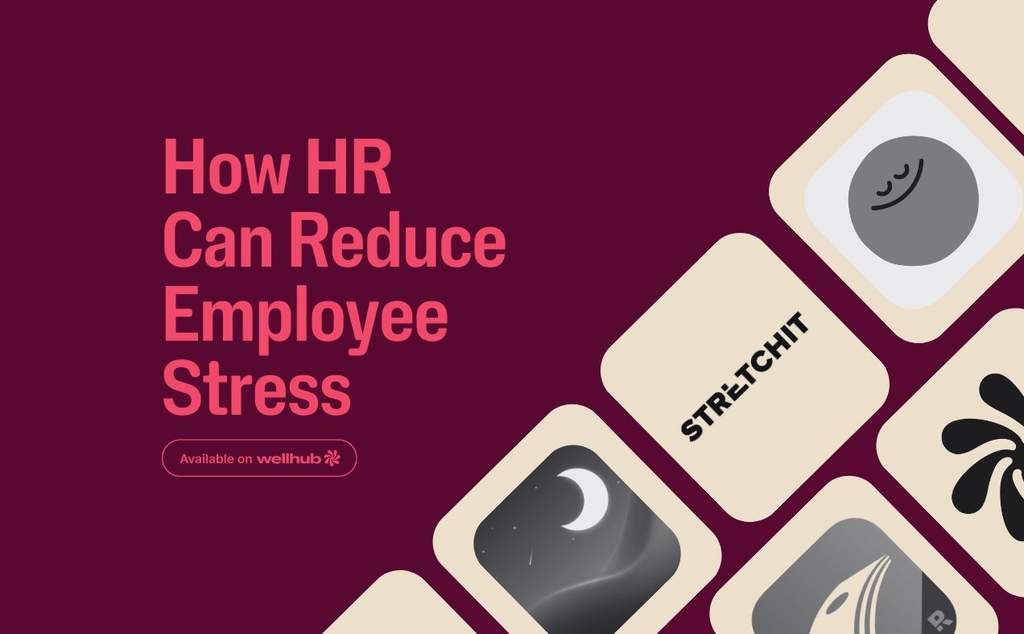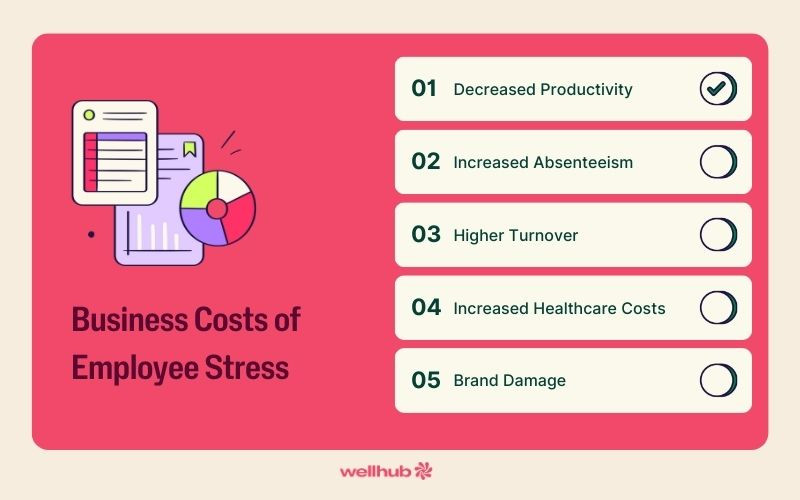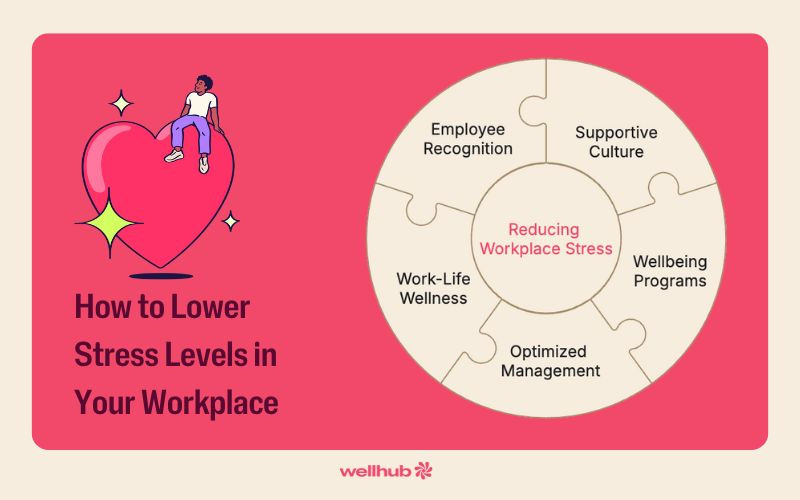18 Proven Strategies HR Leaders Can Use to Lower Workplace Stress
Last Updated Nov 13, 2025

Key Takeaways
- Workplace stress grows when multiple pressures stack and erode an employee’s sense of stability. Heavy workloads, unclear communication, and weak recognition create conditions where people feel strained and unsupported. These patterns set the stage for burnout and disengagement.
- Stress carries measurable business consequences that touch productivity, attendance, and retention. Teams operating in a stressed state struggle to think creatively and maintain momentum. Organizations feel the impact through higher costs, lower performance, and a weakened employer reputation.
- Wellbeing programs offer practical pathways that give employees tools for mental, physical, financial, and sleep health. Apps, coaching, and skill-building resources help people access support without barriers. These solutions make daily challenges easier to manage and increase overall readiness to perform.
- Supportive culture practices strengthen communication, trust, and psychological safety. Employees thrive when they feel heard, respected, and empowered to speak openly. Clear roles, realistic workloads, and room for autonomy shift daily work from reactive to sustainable.
- Strategic rollout and strong framing help HR leaders gain buy-in and show meaningful ROI. Pilots, employee involvement, and steady communication demonstrate value while building internal advocacy. These steps transform wellbeing initiatives into ongoing drivers of resilience and organizational health.
Combat burnout, boost morale, and reduce turnover with stress reduction strategies every HR leader can use to build a healthier workplace.
Nearly half of U.S. employees say work stress is hurting their mental wellbeing. That makes it the number one driver of emotional health issues at work, as revealed in Wellhub’s State of Work-Life Wellness 2025.
That stress doesn’t just stay in people’s heads — workplace stress affects everything. Employee engagement drops. Burnout rises. Turnover accelerates. And your organization's ability to attract and retain top talent? That takes a hit too.
Addressing stress isn’t just the right thing to do. It’s a powerful strategy for building a resilient, high-performing workforce. By creating a culture that protects mental and emotional wellbeing, you strengthen your team from the inside out.
As an HR leader, you’re in the best position to make change happen. Unlock the secrets to reducing stress with 18 proven strategies you can start using today.
What Causes Workplace Stress?
Workplace stress is rarely the result of just one issue. It’s usually a combination of factors that, together, overwhelm employees and undercut performance. HR leaders are uniquely positioned to uncover and address these triggers before they escalate.
- Excessive workload and unrealistic deadlines: When employees are stretched too thin, stress becomes chronic. Long to-do lists, back-to-back meetings, and aggressive deadlines can leave employees feeling like there’s never enough time to catch up. Over time, this can lead to burnout, disengagement, and even turnover.
- Lack of control and autonomy: Employees thrive when they feel trusted. But when every task is micromanaged or every decision must be approved, stress creeps in. Autonomy isn’t just nice to have — it’s essential for engagement and motivation.
- Poor communication and lack of transparency: Uncertainty is a powerful stressor. When leaders withhold information, change direction without explanation, or fail to set clear expectations, employees are left guessing. That guesswork leads to confusion and worry.
- Toxic work culture and negative interpersonal relationships: A workplace without psychological safety can be a minefield. Conflict, exclusion, or even just passive-aggressive communication can create emotional strain that spills into productivity and morale.
- Lack of recognition and appreciation: Employees want to know their work matters. When hard work goes unnoticed, people start to disengage — and stress fills the void. A little appreciation goes a long way.
- Job insecurity and organizational changes: Restructuring. Layoffs. Leadership turnover. When the ground feels like it’s constantly shifting, employees brace themselves for bad news — and that anticipation breeds anxiety.
- Work-life imbalance: Always-on culture blurs boundaries. Without space to rest, connect with loved ones, or take care of personal needs, even top performers hit a wall.
- Inadequate resources and support: High expectations paired with low support is a recipe for stress. Whether it’s outdated tools, short staffing, or lack of training, employees need the right resources to thrive.
The Negative Impact of Stress on the Organization

Unchecked stress affects more than individual employees — it shapes company culture, business outcomes, and even your bottom line.
- Decreased productivity and innovation: When stress levels rise, focus and creativity drop. Employees in survival mode can’t prioritize strategic thinking or innovation — they’re too busy treading water.
- Increased absenteeism and presenteeism: Stress-related illnesses contribute to more sick days, but the bigger issue is presenteeism: showing up while mentally or physically unwell. This quietly drains team performance.
- Higher employee turnover rates: Stressed employees are more likely to leave — and it’s not just because they’re unhappy. They may be seeking roles where they feel seen, supported, and empowered.
- Increased healthcare costs and legal liabilities: Chronic stress is linked to a range of health issues, from heart disease to depression. This means higher insurance claims and potentially greater exposure to legal action if employers don’t meet their duty of care.
- Damage to employer brand and reputation: In today’s transparency-driven job market, employees don’t stay quiet. Sites like Glassdoor and social media amplify stories about poor work environments, making it harder to attract talent.
18 Strategies to Lower Workplace Stress

Implementing Comprehensive Wellbeing Programs
- Mental Wellness Support: Make support easy and stigma-free. Offer access to EAPs, licensed counselors, and mindfulness apps — and consider 1:1 support through services like Headspace Coaching. These nationally certified mental health coaches help employees navigate everyday stress, relationship issues, grief, and burnout with personalized guidance and live chat support. It’s proactive care with a human touch. Over half of employees (51%) say therapy is very or extremely important to their wellbeing — yet 36% who want therapy haven’t started due to cost barriers. Coaching options like these lower the threshold for entry and expand access.
- Physical Health Initiatives: Give employees the tools to move more — and move better. Gym memberships, walking challenges, and group classes are great. So are digital solutions like StretchIt, a flexibility and mobility app offering goal-based stretching programs drawn from pilates, yoga, gymnastics, and dance. With options for 6-minute express sessions or full 45-minute routines, StretchIt empowers employees at every fitness level to reduce stiffness, prevent injuries, and build strength throughout the day. Movement becomes doable, even at a desk.
- Financial Wellbeing Resources: Provide workshops or apps that cover budgeting, debt management, and savings. Financial strain is one of the top barriers to wellbeing — 68% of employees say their financial situation prevents them from investing in themselves. Tools like EveryDollar make budgeting feel more doable and less daunting. Built on the zero-based budgeting method, EveryDollar helps users assign every cent of their income to a purpose — be it bills, savings, or debt payoff. By offering user-friendly solutions like EveryDollar, employers empower their teams to build financial confidence, reduce stress, and take actionable steps toward long-term stability.
- Sleep and Recovery Tools: Sleep isn’t optional for productivity — it’s foundational. Offer tools like ShutEye, a science-backed app that improves sleep quality through personalized tracking, snore detection, meditations, and smart alarms. Employees get tailored sleep insights, daily tips, and relaxation support, helping them wake more refreshed and ready to perform. Better sleep means better mood, sharper focus, and reduced absenteeism.
Fostering a Supportive and Communicative Culture
- Open Communication Channels: Build structures that promote honest dialogue. Regular town halls, anonymous Q&A platforms, and open-door policies invite employees to share feedback and feel heard.
- Psychological Safety: Employees need to feel safe voicing concerns without fear of retaliation. Build this by modeling vulnerability at the leadership level and reinforcing that mistakes are opportunities to grow.
- Active Listening and Empathy Training for Managers: Invest in manager training that prioritizes emotional intelligence. Managers should learn how to listen without interrupting, validate feelings, and ask supportive follow-up questions.
- Promoting Positive Interpersonal Relationships: Create connection points — peer mentorship, cross-functional projects, team offsites. Address toxic behavior immediately with clear policies and supportive coaching.
Optimizing Work Design and Management
- Clear Roles and Responsibilities: Every employee should understand what they own, what success looks like, and how they fit into the bigger picture. Clarity builds confidence.
- Manageable Workloads and Realistic Deadlines: Set expectations that match capacity. Use resource management tools and empower managers to push back on unrealistic demands.
- Employee Autonomy and Control: Empower employees to make decisions within their scope. Autonomy is linked to increased job satisfaction and lower stress.
- Regular Workload Assessments: Make it routine to check in on workload. Use employee pulse surveys or check-in forms to surface red flags before they become burnout.
Promoting Work-Life Wellness
- Flexible Work Arrangements: Remote work, flexible hours, or four-day workweeks help employees fit work around life — not the other way around.
- Encouraging Time Off and Breaks: Normalize unplugging. Leaders should model taking real vacations and promote a culture where rest is respected.
- Setting Clear Boundaries: Encourage communication around availability. Consider "quiet hours" or clear policies for after-hours emails and messages.
Recognition and Appreciation Programs
- Formal and Informal Recognition Systems: Recognition doesn’t need to be fancy — it just needs to be consistent. Peer-nominated awards, spot bonuses, and shout-outs in team meetings all make a difference.
- Regular Feedback and Positive Reinforcement: Train managers to give feedback that’s timely, actionable, and kind. Positive reinforcement builds momentum and motivation.
- Celebrating Milestones and Successes: Whether it’s project wins, birthdays, or work anniversaries — find regular opportunities to celebrate your team.
The Business Case for Prioritizing Employee Wellbeing
Investing in stress reduction and wellbeing isn’t just good ethics — it’s good business.
- Improved Productivity and Engagement: 99% of HR leaders say their wellbeing program increased productivity, with nearly half seeing major gains, according to Wellhub's Return on Wellbeing 2024 report.
- Reduced Absenteeism and Turnover: 98% of HR leaders report lower turnover thanks to wellbeing initiatives. These programs reduce burnout, improve morale, and help people stick around.
- Enhanced Employer Brand: Gen Z and Millennials are more likely to leave jobs that don’t support wellbeing. Creating a supportive culture is now a top talent acquisition strategy.
- Legal and Ethical Considerations: HR leaders have a duty to support psychological safety. Proactively managing stress is part of building an inclusive and compliant workplace.
Overcoming Challenges and Gaining Buy-in
Rolling out stress-reduction initiatives may seem like a no-brainer, but even the most compelling programs can hit roadblocks. Budget constraints, resistance to change, leadership skepticism, and uncertainty about ROI are all common hurdles. But with a strategic approach, HR leaders can turn hesitation into momentum.
Anticipate Pushback — and Prepare to Address It
Stress-reduction strategies can be met with comments like:
- "We don’t have the budget for this."
- "Our team is too busy."
- "It won’t make a difference."
- "Employees won’t use these resources anyway."
These objections often stem from outdated perceptions or competing priorities — not a lack of care. The key is to shift the conversation from cost to value, and from theory to evidence.
Tactics to Secure Support and Drive Adoption
With the right framing, data, and champions, your wellbeing initiatives can gain the traction they deserve — and deliver meaningful change that sticks.
- Start with ROI: Share real data that connects wellness to business outcomes. Wellhub’s Return on Wellbeing 2024 found that 95% of HR leaders who track ROI see positive returns from wellbeing programs, with major gains in productivity, engagement, and retention. Lead with numbers that matter to your CFO or CEO.
- Launch a pilot program: Begin with one team, one department, or one initiative. Keep the scope manageable and the goals clear. A successful pilot gives you a proven model to scale, with internal champions who can speak to its impact.
- Involve employees in the design process: Survey your people. Host listening sessions. Ask what they want — and build accordingly. Programs co-created with employees are more relevant, more inclusive, and more likely to be used. They’re also easier to defend when the results start rolling in.
- Build a network of champions: Identify well-respected leaders who believe in wellbeing and are willing to model the behaviors you want to see. These individuals can influence team norms, rally support, and create pockets of cultural change that spread organically.
- Communicate impact early and often: Track engagement, capture testimonials, and highlight success stories across internal channels. Share quotes from employees who are sleeping better, feeling supported, or finally attending therapy. Data matters, but emotion moves people too.
- Reframe the narrative: Position wellbeing as a business resilience strategy, not a nice-to-have perk. Show how stress management helps teams weather uncertainty, navigate change, and deliver consistent performance under pressure.
- Connect it to strategic priorities: Tie your program to broader company goals — whether it's improving employee engagement, reducing healthcare costs, or enhancing DEI. When stress-reduction aligns with mission-critical metrics, buy-in becomes a shared goal, not a siloed initiative.
Supporting Stress Reduction with Workplace Programs
Workplace stress is real — and it’s taking a toll. It’s driven by a many sources, including heavy workloads, poor communication, and blurred boundaries. And when left unaddressed, it undermines performance, retention, and culture.
That’s where employee wellbeing programs come in. By making it easier to access therapy, move your body, manage finances, and take care of your health, they support the whole person. And the business case is strong: 91% of companies with wellbeing programs report reduced healthcare costs, and 98% report lower turnover.
Speak with a Wellhub wellbeing specialist to build a workplace that helps employees thrive — and keeps your business thriving, too.

Company healthcare costs drop by up to 35% with Wellhub*
See how we can help you reduce your healthcare spending.
[*] Based on proprietary research comparing healthcare costs of active Wellhub users to non-users.
References
- Wellhub (2024, October 16). The State of Work-Life Wellness 2025. https://wellhub.com/en-us/resources/research/work-life-wellness-report-2025/
- Wellhub (2024, May 16). Return on Wellbeing 2024. https://wellhub.com/en-us/resources/research/return-on-wellbeing-2024/
Category
Share

The Wellhub Editorial Team empowers HR leaders to support worker wellbeing. Our original research, trend analyses, and helpful how-tos provide the tools they need to improve workforce wellness in today's fast-shifting professional landscape.
Subscribe
Our weekly newsletter is your source of education and inspiration to help you create a corporate wellness program that actually matters.
Subscribe
Our weekly newsletter is your source of education and inspiration to help you create a corporate wellness program that actually matters.
You May Also Like

How to Calculate and Reduce Employee Turnover Rate | Wellhub
Use this guide to calculate and analyze your employee turnover rate. Discover strategies to boost retention and reduce turnover in your organization.

Quiet Quitting: What It Is, Causes, and Solutions | Wellhub
Quiet quitting signals low engagement and burnout. Learn what causes it and how to prevent it through support and balance.

How to Help a Workaholic Employee | Wellhub
Is your employee a workaholic? Discover the signs, causes, and how to help a workaholic achieve better work-life balance and improve productivity.